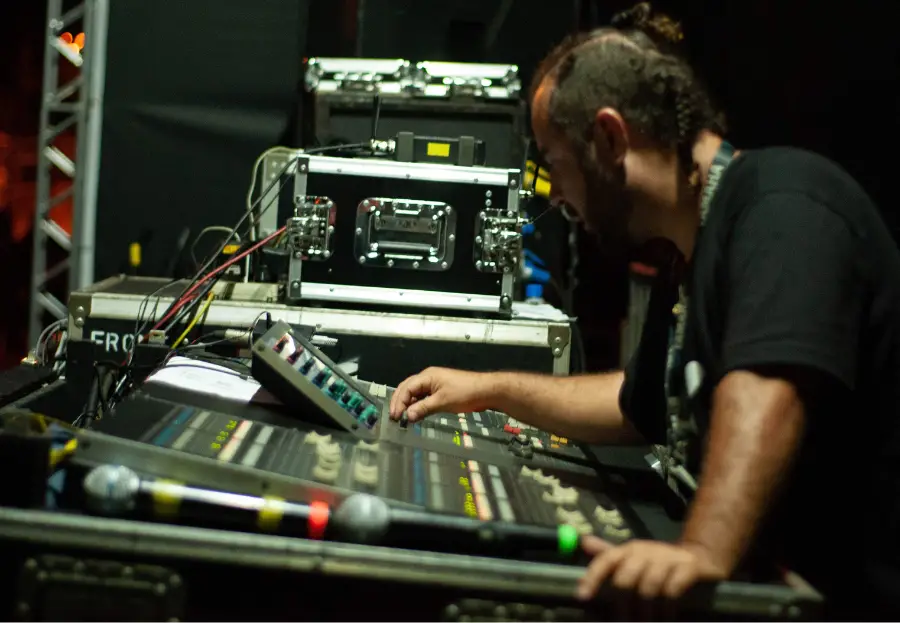Church Sound Systems
1. Church Auditorium Sound Solutions
The ‘Auditorium Sound System with 4 SD5 SuperDispersion Ceiling Speaker Arrays and RMA350BT 350W Rack Mount Bluetooth Mixer Amplifier’ is a solution for exceptional audio distribution in church auditoriums. It provides 360° sound coverage, ensuring consistent audio quality for all attendees.
The Bluetooth-enabled mixer amplifier allows for easy attachment of devices for varied media presentations or traditional sermons. The four SD5 SuperDispersion ceiling speaker arrays conquer challenges posed by extensive church auditoriums, broadcasting sound in a manner that minimizes echo and maximizes intelligibility.
The system’s design is intended for simplicity, with plug-and-play functionality that minimizes installation complexity. It balances cost-efficiency and quality, making it a worthy investment for improving parishioners’ experience during worship and church functions.
The sturdy build and quality components suggest a durable solution that can handle frequent usage in church environments, ensuring long-term reliability without degradation in sound quality.

2. Church Sanctuary Audio Systems
The ‘JBL CBT 100LA-1 Line Array Column Loudspeaker and Bluetooth Mixer Amplifier’ is a sophisticated setup that lends exceptional clarity and focus to church services in sanctuaries. Its streamlined vertical design offers a directive sound dispersion pattern that adeptly targets the listener area while reducing reverberations against walls and ceilings.
The Bluetooth capability in the mixer amplifier allows for straightforward streaming of sermons or hymns from digital devices, amplifying the system’s adaptability for multiple uses. The ‘JBL CBT 100LA-1’ is visually unobtrusive and synchronizes well with the sanctuary’s aesthetics, ensuring sound technology complements the spiritual atmosphere without becoming a distraction.
With affordability paired with excellent performance metrics, this configuration ensures every word and note achieves depth and reach, vital for immersive worship experiences that engage every congregation member.
3. Yamaha’s Church Audio Setup
Yamaha’s sound system setup, comprising IF2115/95 Loudspeakers paired with the Soundcraft FX16ii Mixer, addresses issues like uneven sound distribution and acoustic dead zones in churches. The IF2115/95 loudspeakers deliver precise sound that penetrates every corner of the gathering space, ensuring homogeneity in sound levels.
The Soundcraft FX16ii Mixer, with its 26 inputs, delivers substantial versatility for managing multiple microphones or connecting instruments. Each channel offers individual adjustment settings, empowering operators to fine-tune audio elements to perfection.
- These systems balance advanced functionalities with user-friendly interfaces, making them suitable for both professional sound engineers and volunteers with basic training.
- They are flexible, enabling churches to build upon existing setups or design new ones from scratch, conforming to spatial and architectural nuances.
Yamaha’s combination of IF2115/95 Loudspeakers with the Soundcraft FX16ii mixer offers an adaptive and potent solution for churches wrestling with complex acoustic challenges, delivering crisp, clear, and compelling sound that engages congregates deeply and universally.
4. Advancements in Digital Audio for Churches
Dante digital audio technology provides a streamlined approach to audio networking, transmitting audio signals seamlessly across various devices. It manages multiple high-quality audio channels, allowing for flexibility and scalability within church audio infrastructure.
Digital Signal Processors (DSPs) bring an added layer of sophistication, tuning and controlling audio processing functions such as mixing, equalization, and feedback suppression. They help achieve a balanced audio mix, ensuring volume levels are harmonious and each element of the service is placed correctly in the audio spectrum.
The combination of Dante digital audio and DSP technology empowers church technical teams to deploy sophisticated audio configurations with enhanced ease and efficiency. It symbolizes a leap from manual setups to automated, reliable, and repeatable audio performances.
Embracing these technologies reflects the technological progression in audio systems and underlines a commitment to uplift the spiritual experience through refined acoustical excellence. They are significant contributors to the overall sacred ambiance of worship, carving out spaces where clarity meets devotion seamlessly.
5. Choice of Amplifiers and Speakers for Churches
Class D amplifiers and versatile Digital Signal Processors (DSPs) have emerged as frontrunners in church installations due to their technological efficiencies and configuration options. Class D amplifiers are highly efficient in power conversion and output stages, generating less heat and allowing for lighter and more compact designs.
They deliver impressive power outputs that effectively drive speeches and music across spacious worship halls, ensuring clear audio delivery reaches every pew. Their consistent performance at varying power levels makes them dependable during different church activities.
DSPs manage and manipulate audio signals to enhance sound quality. They enable complex configurations like multi-zone sound distribution, adaptability to different acoustics, and fine-tuning audio outputs for specialty services.
DSPs facilitate innovative uses such as creating acoustic variations for smaller chapels or outdoor services. They effortlessly handle inputs from various microphones, musical instruments, and source media, providing flexibility for any type of service or event.
In conjunction with well-selected speakers, Class D amplifiers enhanced with DSPs offer a broad canvas for audio system designers. They enable churches to optimize their existing spaces and plan for future enhancements or expansions.
Integrating these advanced audio options imbues church facilities with the capacity to deliver sound that elevates the clarity and reach of every message and melody, providing an uplifting experience for every congregation member.

6. Custom Tailored Church Sound Systems
Every church space, congregation, and style of worship is unique, requiring a customized approach to its sound system needs. Crafting custom sound systems involves understanding various components such as mixers, speakers, and microphones, and how to modify these to suit specific church requirements.
The church’s architecture drives the choice of speakers. Beam-steering technology in line array speakers can be employed in large and acoustically challenging environments, directing sound precisely where needed while minimizing echoes. Point-source speakers may suffice in smaller spaces, delivering clearer audio without acoustic hurdles.
Input from those who use the space is crucial. Older, traditional congregations may lean towards a simple setup focused on vocals and organ amplification, whereas contemporary services with various musical instruments and robust choirs might require a comprehensive multi-channel mixer to manage dynamic ranges and multiple inputs.
Customization extends to fine-tuning speaker placement for homogenous sound coverage while optimizing mixer settings to stabilize sound levels across different audio outputs. Digital mixers combined with DSPs (Digital Signal Processors) enable operators to dial in precise settings that correct room anomalies and alter acoustics.
Selecting microphones suited for their purpose offers potential enhancements. Choirs benefit from hanging condenser microphones that collect expansive sound without intrusive stands, while pastors or lecturers may prefer lapel mics for freedom of movement.
Expandable digital mixers can accommodate future needs or growth, integrating seamlessly with existing setups, ensuring the audio system continues to meet evolving demands.
Understanding the interplay of different technologies and components while considering the specific requirements of a church fosters an environment where technology complements spirituality harmoniously. Attention to detail in customizing a sound system ensures that every sermon reaches the last row clearly and every note of hymns flows unimpeded.
7. Key Components of Church Sound
A mix of key components comes together in a church’s audio system to resonate sound, spirit, and connectivity. Here’s a breakdown of these foundational pieces:
- Microphones: From handheld dynamic microphones for sermons to choir microphones that capture harmonies, each type plays a distinct role. Varieties range from lavalier mics for discretion to shotgun mics adept at zeroing in on specific audio sources.
- Mixers: Audio mixers manage every input and output, balancing levels, tuning frequencies, and refining signals to maintain clarity. Digital mixers allow memorization of settings for seamless transitions between speakers and musicians.
- Amplifiers: Amplifiers amplify audio signals, powering speakers to fill the church with meaningful decibels. Energy-efficient Class D amplifiers create an awe-inspiring auditory impact without compromising energy consumption or heat production.
- Speakers: Speakers determine how evenly sound travels through the air and across the congregation. Selecting between point source and column arrays, or a hybrid fitting for extensive settings, depends on architectural aesthetics and acoustic challenges.
- Digital Signal Processors (DSPs): DSPs tweak audio signals digitally to optimize the audio landscape, dialing down echo, enhancing clarity, and avoiding feedback loops.
- Equalizers: Equalizers carve out specific frequencies that aren’t fitting well within the church’s walls, enhancing speaker efficiency by compensating for unique acoustic quirks.
- Assisted Listening Systems: These systems ensure inclusivity by offering headsets linked directly to the main system, allowing worshipers with hearing impairments to partake in every aspect of the service.
Choosing and configuring components that work harmoniously within the unique acoustical environment of each worship space is key to effective church sound systems. This careful selection ensures that every message and melody reaches every attendee with clarity, making each service a more immersive and spiritually enriching experience.













